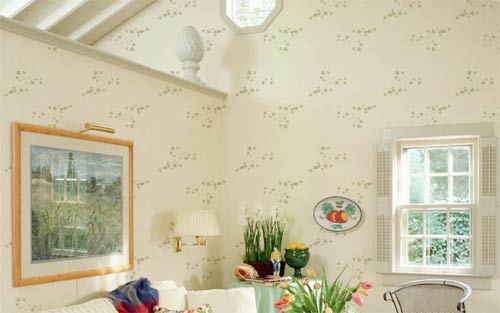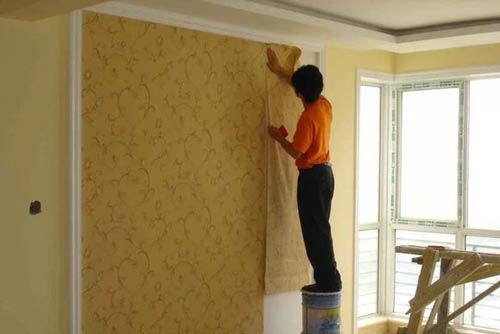The colorful wallpaper pattern has a good decorative effect on the living room. However, the paving of the wallpaper requires a high degree of workmanship and requires professional workers to construct it. If the paste is not good, it will have a great influence on the effect of the later stage. For the general For the owners, perhaps they do not need to put their own hands on wallpaper, but they should understand the rules of how to paste wallpapers before they can supervise and grasp the construction of workers.

How to paste wallpaper - preparatory work
Wallpaper usage and purchase
1, the general area of ​​the room × 3 & spanide; 5.2 = the number of rolls required for the conventional (a roll of wallpaper is generally 52 cm wide, 10 meters long, an area of ​​5.2 square meters). For the sake of safety, a roll should be added to the number of rolls that are generally required.
2, in order to avoid color, at the time of purchase should pay attention to each roll of wallpaper number and batch number is the same.

Glue purchase
Wherever you sell wallpapers, there are special wallpaper glues. It is important to pay attention to environmental protection. The white glue is used more, it is transparent after dry, and it is generally used with wallpaper glue powder; the transparent glue has strong adhesion and is more advantageous when used for uneven wallpaper and metal special wallpaper. In addition, some owners reported that Japanese glutinous rice is very good for children's rooms.
How to paste wallpaper - tools
Glue, brush, towel, sponge, sandpaper, knife, scraper, tape measure, plastic container, gypsum powder, bandage, etc.
How to paste wallpaper - construction steps
1, first of all measure the size of the wall.
2. Eradicate the wall: remove the original paint, wallpaper and other objects on the wall. If there are cracks or potholes on the wall, use gypsum powder to replenish these areas and put a bandage on the surface; if there is a dusty wall or a partition wall, stick a glass cloth or a good cloth; some poor quality partitions Or to achieve the insulation effect of the external wall, full nail plasterboard.
3, cut wallpaper: measure the height of the wall to the baseboard, and then cut the wallpaper. Don't add 10 centimeters to the wall height of the flower wallpaper, use it for trimming the edges; need to consider the symmetry of the pattern, need more than 10 centimeters, and from the top should be on the flower, plan after cutting, numbering, So you can paste them in order. General wallpaper is not recommended for wet stickers.

4, brush base film greasy: brush the bottom film, the base film even brush on the wall, the thickness of moderate; scraping putty, polished. Two batches of scraping putty on the wall. After the putty is air-dried, use a sandpaper to polish the wall surface, remove uneven granules, make the wall smooth and flat, and use the base film to evenly paint the wall (cover paint), without being too thick. This will prevent the walls from absorbing the wallpaper glue, sticking the wallpaper on the wall and making the walls even.
5, brush glue : In order to ensure that the paste firmly, the back of the wallpaper and the wall should be brushing glue, glue to brush evenly, can not be wrapped, from the heap, to prevent soiling wallpaper. Gum on the wall, the width should be 30 mm wider than the wallpaper. After brushing on the back of the wallpaper, the glue is placed on the face and folded for 5 minutes. It can prevent the glue surface from drying out quickly and is not easily contaminated.
6, cutting wallpaper: before cutting a good amount of length, the general standard wallpaper each roll 10 meters long, 0.52 meters wide, you can shop 5.2 square meters. The other two specifications are 7 square/roll, 16 square/roll.
7, paste: The principle is the first vertical level, first up and down, first high and low. When affixing the first piece of paper, look for a reference line at the corner of the wall, gently press down from the top to the bottom, from the center to the sides, and scrape with a scraper to make the wallpaper and the wall stick. When affixing the second wallpaper, overlap with the overlap of the first paper web by 20 mm, divide the overlapping portion with a wallpaper knife, remove the remaining portion, and scrape with a scraper. It should be noted that the glue that is squeezed out of the wallpaper should be wiped clean with a wet towel in time to prevent the wallpaper from turning yellow.

8. When sticking the wallpaper: Use a roller to evenly coat the wallpaper glue on the wallpaper. For thicker wallpapers, it should be left for a while. When starting the wallpaper, for the seams, both sides of the adjacent two wallpapers are squashed to make them fit. Then, the seams are pressed with a scraper and the extruded glue is cleaned. After the wallpaper is pasted, use the scraper to paste the wallpaper from top to bottom.
How to paste wallpaper - Notes
â– Before construction, you should carefully check the color number and batch number of the wallpaper. And to understand the type of wallpaper to be constructed, the colored paper needs to be flowered, and the plain paper must be constructed in the opposite direction.
â– The quality of the glue will directly affect the overall effect and useful life of the wallpaper, so it is necessary to purchase authentic brands of glue or wall paint.
â– Dry sticking, that is, the method of applying glue directly on the back of the wallpaper, mainly for plastic surface wallpaper. Cross cloth and non-woven bottom wallpaper do not need to be glued.
â– Concentration of glue concentration is judged by whether a chopstick can stand in glue.
â– During the construction of plain paper wallpaper, it is not allowed to scratch or wipe the glue on the paper surface to avoid contaminating the surface of the wallpaper.
â– Don't throw away scattered wallpapers for later use

â– After the wallpaper is attached, close the doors and windows. Do not open the window in the window and allow the wallpaper to dry slowly.
■When the wall needs to hang oil paintings or other accessories, a “V†shape should be drawn on the nailed wallpaper for later repair.
â– After the paper is pasted, close the doors and windows for 2-3 days to let the wallpaper dry naturally. Remember not to turn on air conditioners or other air conditioning equipment to prevent the wallpaper from shrinking and causing cracks.
â– During the wet season, doors and windows should be opened during the day to prevent the invasion of moist gas.
â– The paper has a certain scrub resistance, so if it is stained, it can be wiped gently with soap or other cleaning agent.
â– Wallpapers with embossed patterns can be cleaned once with a vacuum cleaner every 2-3 months. Simply use the chicken feathers for cleaning on weekdays.
â– Do not use a hard object such as a back or a desk to strike or rub against the wall to avoid damaging the wall. If damage to the surface of the small area is found, a color-approaching paint or paint remedy can be used. In this way, the wallpaper-decorated living room will maintain a beautiful and clean effect after several years.
Related Reading:
Wallpaper detailed steps (Photos)
Using wallpaper to perfectly decorate three types of home space defects
Do not know 5 important construction points
Graphic explanation: the whole process of wallpaper paving
Summer decoration decoration wallpaper should pay attention to what issues?
Several stylish ways to create a new bedroom effect wallpaper
Wallpaper wallpaper decoration construction knowledge wallpaper window paint decoration home home wallpaper glass table glass door decoration home
Custom Drawing Round Aluminium Wheel Die Casting
|
Product |
Aluminum die casting parts or Pure Aluminum die casting parts |
|
Application |
Atuo Motor part machinery fittings |
|
Used Die cast Machine (Depend on mould) |
Die casting machine 120 ton -800 ton |
|
Main Processes Flow (depends on part shape and requirement) |
Drawing / or Samples →Mould making →Die casting →Deburring →Drilling and Tapping →CNC Machining →Polish→Surface treatment →Assembly →Quality inspection → Packing →Shipping |
|
Production Flow |
Drawing/ or samples → Mould making →Die casting and other processes →Get samples and send samples to customer for approval → Mass Production ( casual inspection avoid unintentional situation) → QC → Packing →Shipping →Cycle to next order |
|
Surface Treatment (Optional by customer) |
Polishing, Sandblasting, Painting, Powder coating, Galvanizing, Chrome plating Anodizing , Real gold coating, Imitation gold, |
|
Drawing file ( 2D or 3D) |
In format of IGS, STEP, SLD,X_T, DXF, DWG, SAT, STL ,PDF |
|
Production Management |
ISO, 5S Management, Signboard Management, |
|
Our advantages |
In-house tool / mould making, mould design team , In- house die cast, Assembly line Exporting Experiences. |
Q:What infromation need for an accurate quotation for your part ?
-A sample part, or a drawing of your part or a 3D model of your part;
-The weight of your part;
-Which alloy you plan to use;
-Your estimated usage quantity;
-A description of your secondary processing requirements such as machining or finishing.
Q:What are the size limits of aluminum die casting parts?
-Depending on the shape of the part we can produce castings weighing as little as 3g to as much as 13 kgs.
Q: What tolerances can be met?
-The standard tolerance for is aluminum die casting is ±0.005" higher levels of tolerance are possible for areas of critical requirements and these can be achieved by special arrangements and planning in the mold design stage.
The best we can do ±0.002" Continuous tolerance limit!
Q:How about the limit of wall thickness?
The minimum wall thickness for Aluminum is 0.08"
Die Cast Aluminum,Aluminum Costing Round Wheel,Aluminum Die Casting Wheels,Aluminum Die Casting Hand Wheel
Dongguan Hongge Hardware Technology Co., Ltd , http://www.honggecasting.com